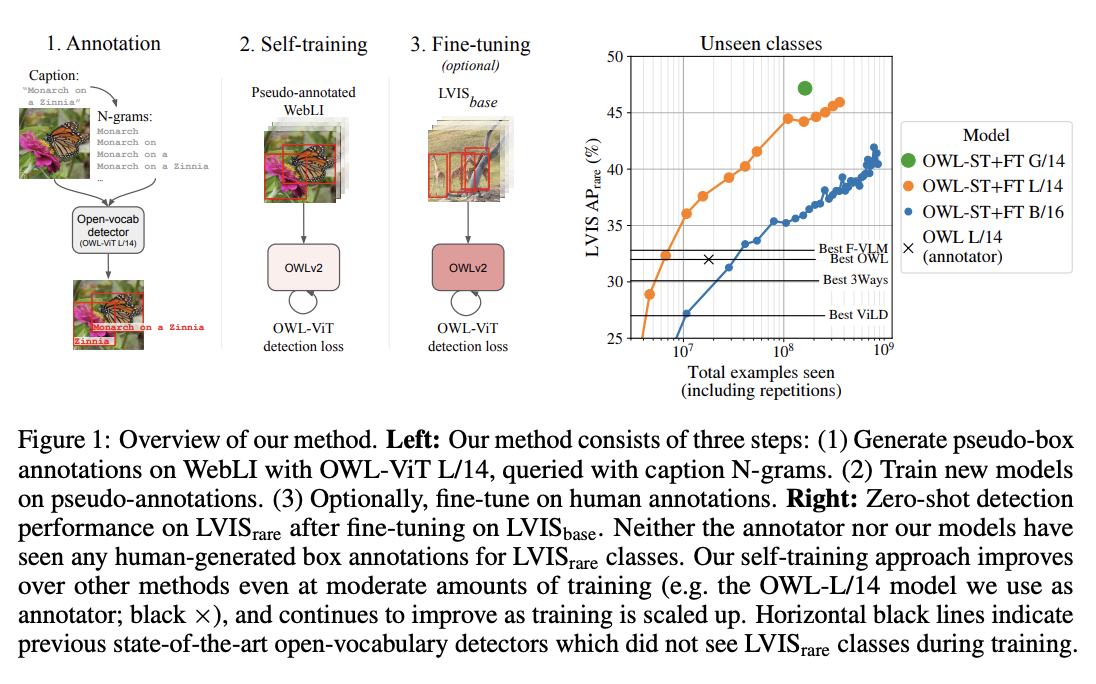7.0 KiB
OWLv2
Overview
OWLv2 was proposed in Scaling Open-Vocabulary Object Detection by Matthias Minderer, Alexey Gritsenko, Neil Houlsby. OWLv2 scales up OWL-ViT using self-training, which uses an existing detector to generate pseudo-box annotations on image-text pairs. This results in large gains over the previous state-of-the-art for zero-shot object detection.
The abstract from the paper is the following:
Open-vocabulary object detection has benefited greatly from pretrained vision-language models, but is still limited by the amount of available detection training data. While detection training data can be expanded by using Web image-text pairs as weak supervision, this has not been done at scales comparable to image-level pretraining. Here, we scale up detection data with self-training, which uses an existing detector to generate pseudo-box annotations on image-text pairs. Major challenges in scaling self-training are the choice of label space, pseudo-annotation filtering, and training efficiency. We present the OWLv2 model and OWL-ST self-training recipe, which address these challenges. OWLv2 surpasses the performance of previous state-of-the-art open-vocabulary detectors already at comparable training scales (~10M examples). However, with OWL-ST, we can scale to over 1B examples, yielding further large improvement: With an L/14 architecture, OWL-ST improves AP on LVIS rare classes, for which the model has seen no human box annotations, from 31.2% to 44.6% (43% relative improvement). OWL-ST unlocks Web-scale training for open-world localization, similar to what has been seen for image classification and language modelling.
Tips:
- The architecture of OWLv2 is identical to OWL-ViT, however the object detection head now also includes an objectness classifier, which predicts the (query-agnostic) likelihood that a predicted box contains an object (as opposed to background). The objectness score can be used to rank or filter predictions independently of text queries.
- Usage of OWLv2 is identical to OWL-ViT with a new, updated image processor ([
Owlv2ImageProcessor]).

OWLv2 high-level overview. Taken from the original paper.
This model was contributed by nielsr. The original code can be found here.
Usage
OWLv2 is, just like its predecessor OWL-ViT, a zero-shot text-conditioned object detection model. OWL-ViT uses CLIP as its multi-modal backbone, with a ViT-like Transformer to get visual features and a causal language model to get the text features. To use CLIP for detection, OWL-ViT removes the final token pooling layer of the vision model and attaches a lightweight classification and box head to each transformer output token. Open-vocabulary classification is enabled by replacing the fixed classification layer weights with the class-name embeddings obtained from the text model. The authors first train CLIP from scratch and fine-tune it end-to-end with the classification and box heads on standard detection datasets using a bipartite matching loss. One or multiple text queries per image can be used to perform zero-shot text-conditioned object detection.
[Owlv2ImageProcessor] can be used to resize (or rescale) and normalize images for the model and [CLIPTokenizer] is used to encode the text. [Owlv2Processor] wraps [Owlv2ImageProcessor] and [CLIPTokenizer] into a single instance to both encode the text and prepare the images. The following example shows how to perform object detection using [Owlv2Processor] and [Owlv2ForObjectDetection].
>>> import requests
>>> from PIL import Image
>>> import torch
>>> from transformers import Owlv2Processor, Owlv2ForObjectDetection
>>> processor = Owlv2Processor.from_pretrained("google/owlv2-base-patch16-ensemble")
>>> model = Owlv2ForObjectDetection.from_pretrained("google/owlv2-base-patch16-ensemble")
>>> url = "http://images.cocodataset.org/val2017/000000039769.jpg"
>>> image = Image.open(requests.get(url, stream=True).raw)
>>> texts = [["a photo of a cat", "a photo of a dog"]]
>>> inputs = processor(text=texts, images=image, return_tensors="pt")
>>> outputs = model(**inputs)
>>> # Target image sizes (height, width) to rescale box predictions [batch_size, 2]
>>> target_sizes = torch.Tensor([image.size[::-1]])
>>> # Convert outputs (bounding boxes and class logits) to COCO API
>>> results = processor.post_process_object_detection(outputs=outputs, target_sizes=target_sizes, threshold=0.1)
>>> i = 0 # Retrieve predictions for the first image for the corresponding text queries
>>> text = texts[i]
>>> boxes, scores, labels = results[i]["boxes"], results[i]["scores"], results[i]["labels"]
>>> for box, score, label in zip(boxes, scores, labels):
... box = [round(i, 2) for i in box.tolist()]
... print(f"Detected {text[label]} with confidence {round(score.item(), 3)} at location {box}")
Detected a photo of a cat with confidence 0.614 at location [341.67, 17.54, 642.32, 278.51]
Detected a photo of a cat with confidence 0.665 at location [6.75, 38.97, 326.62, 354.85]
Resources
A demo notebook on using OWLv2 for zero- and one-shot (image-guided) object detection can be found here.
Owlv2Config
autodoc Owlv2Config - from_text_vision_configs
Owlv2TextConfig
autodoc Owlv2TextConfig
Owlv2VisionConfig
autodoc Owlv2VisionConfig
Owlv2ImageProcessor
autodoc Owlv2ImageProcessor - preprocess - post_process_object_detection - post_process_image_guided_detection
Owlv2Processor
autodoc Owlv2Processor
Owlv2Model
autodoc Owlv2Model - forward - get_text_features - get_image_features
Owlv2TextModel
autodoc Owlv2TextModel - forward
Owlv2VisionModel
autodoc Owlv2VisionModel - forward
Owlv2ForObjectDetection
autodoc Owlv2ForObjectDetection - forward - image_guided_detection